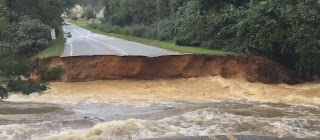Hurricane Matthew's US Death Toll Rises to 9; Nearly 2 Million Without Power
By J.J. GALLAGHER
JULIA JACOBO Oct 8, 2016, 4:37 PM ET
 David Goldman/AP PhotoWATCH Hurricane Matthew Batters Florida, Brings Travel Trouble to the Southeast
David Goldman/AP PhotoWATCH Hurricane Matthew Batters Florida, Brings Travel Trouble to the Southeast At least 9 people in two U.S. states have died as a result of Hurricane Matthew, which has also left 1.9 million households and businesses without power across the Southeast region. The death toll increased as the storm moved up the Atlantic Coast, bringing torrential rain, powerful winds, a storm surge and the potential for catastrophic flooding.
North Carolina Gov. Pat McCrory said Saturday that the state recorded three storm-related deaths -- one in Samson County due to hydroplaning and two in Bladen County after a vehicle was submerged in flood water.
"This is a very serious and deadly storm," McCrory said at a press conference Saturday afternoon. He urged the public to stay off roads and remain indoors.
Six people also lost their lives in Florida due to the storm, which at one point left 1 million households and businesses without power in the Sunshine State.
The storm touched down in South Carolina, southeast of McClellanville, at 11 a.m. ET as a Category 1 hurricane with maximum sustained winds of 75 mph, according to the National Hurricane Center.
It is expected to weaken further to a post-tropical storm by Saturday night, ABC News meteorologists said.
Despite the storm's weakening, the National Hurricane Center warned Saturday morning of "strong winds and dangerous storm surge" along South Carolina's coast as well as "heavy rains and gusty winds spreading inland."
The National Weather Service also posted a new tornado watch for parts of northeast South Carolina and eastern North Carolina until 4 p.m. ET Saturday.
"An isolated tornado or two will be possible today along the coast of North Carolina and northern South Carolina," the National Hurricane Center, a division of the National Weather Service, said in its advisory at 8 a.m. ET. “Although weakening is forecast during the next 48 hours, Matthew is expected to remain a hurricane while the center is near the coasts of South Carolina and North Carolina."
 ABC NewsThe threat for isolated tornadoes along the southeast U.S. coast continues from Myrtle Beach, South Carolina to Wilmington and New Bern, North Carolina, where a tornado watch is in effect until 4 p.m. ET.more +
ABC NewsThe threat for isolated tornadoes along the southeast U.S. coast continues from Myrtle Beach, South Carolina to Wilmington and New Bern, North Carolina, where a tornado watch is in effect until 4 p.m. ET.more + Tracking Hurricane Matthew
Earlier Saturday, Hurricane Matthew brushed Georgia's coast on its way up the shoreline. As of 2:30 p.m. ET, the hurricane was moving northeast at 12 mph with the eye of the storm right near Myrtle Beach, South Carolina. A flash flood emergency was issued for Myrtle Beach and surrounding areas, with more than a foot of rain falling in some spots.
"On the forecast track, the center of Matthew will continue to move near or over the coast of South Carolina today, and be near the coast of southern North Carolina by tonight," the National Hurricane Center said Saturday in its 8 a.m. ET advisory.
"While weakening continues ... the storm movement will be picking up speed, significant impacts will continue for about the next 24 hours," ABC News meteorologist Daniel Peck said Saturday. "Our biggest concern is extreme rainfall and flash flooding."
 ABC NewsHurricane Matthew made landfall southeast of McClellanville, South Carolina, as a Category 1 storm on Saturday at 11 a.m. ET. The hurricane is expected to weaken further to a post-tropical storm as early as Sunday night.
ABC NewsHurricane Matthew made landfall southeast of McClellanville, South Carolina, as a Category 1 storm on Saturday at 11 a.m. ET. The hurricane is expected to weaken further to a post-tropical storm as early as Sunday night. Dangerous Combination of Winds, Rain and Storm Surge
As of late Saturday afternoon, Matthew's hurricane-force winds extended outward up to 45 miles from the storm's center off the South Carolina coast, while somewhat less strong winds extended outward up to 185 miles. Wind gusts of 76 mph were reported at South Carolina's Folly Beach and 55 mph in Orangeburg.
Storm surges that could cause flooding have a been a concern up and down the coast. The National Weather Service measured a record tide level of more than 12 feet at the mouth of the Savannah River, which borders both South and North Carolina. Forecasters warned that the combination of a dangerous storm surge, the tide and large waves could cause rising waters to move inland from the shoreline to flood normally dry areas near the coast.
The water level could rise above ground as high as 9 feet in some spots from North Carolina south. The National Hurricane Center warned early Saturday of "life-threatening inundation" along the coastline during the next 36 to 48 hours.
On Saturday, Charleston County Emergency Medical Services in South Carolina suspended its service countywide, warning that high-span or exposed bridges are unsafe for public travel due to high winds. A curfew was implemented in Charleston between Saturday 8 p.m. ET through Sunday 8 a.m. ET.
Hurricane Matthew is expected to produce a total of 8 to 12 inches of rain near and east of I-95 in South and North Carolina, with the possibility of up to 15 inches in isolated spots. Forecasters said the rainfall accumulation could result in deadly floods and flash flooding.
Nearly 17 inches of rain were recorded at Hunter U.S. Army Airfield in Savannah, Georgia over a 48-hour period, according to the National Hurricane Center.
Over 342,000 homes and businesses were without power in Georgia, 663,000 in South Carolina and 200,000 in North Carolina on Saturday, as officials worked to restore electricity. Floodwaters, downed trees and debris clogged roads in much of Matthew's storm path across three states, rendering I-95 in South Carolina impassible early Saturday.
FEMA Administrator Craig Fugate said Friday, "Many of these areas have not had this level of flooding since, like, the late 1800s."
 Jonathan Drake/ReutersFlood waters submerge the historic city market area as Hurricane Matthew hits Charleston, South Carolina, Oct. 8, 2016.
Jonathan Drake/ReutersFlood waters submerge the historic city market area as Hurricane Matthew hits Charleston, South Carolina, Oct. 8, 2016. Millions Brace for Matthew's Wrath
Authorities in Georgia and the Carolinas this week urged coastal residents to head inland as the most powerful Atlantic storm in more than a decade continued on its path along the southeast U.S. coast.
In Georgia, Gov. Nathan Deal has ordered mandatory evacuations east of I-95 along the entire Georgia coast, which is home to popular beach towns like Tybee Island.
"There comes a point where we cannot jeopardize the lives of our first responders any further," Deal said during a news conference Friday.
The governor added that he knows people who evacuated are anxious to return home, but they should not put their lives at risk by going back too soon.
"I don't intend to prosecute anyone for not leaving," Deal said. "I think Mother Nature will take care of them."
As of Friday, 9,000 people are in 30 shelters in Georgia.
Joseph Jarrard, the adjutant general of the Georgia Army National Guard, said an additional 1,000 troops were deployed Friday night, bringing the total number in the Peach State to 2,000.
There have been no reports of major damage or major flooding yet in Savannah and Tybee Island, Georgia. But there are reports of fallen trees and downed power lines, officials said at a press conference Saturday morning.
All of Georgia's barrier islands have experienced storm surges that have surpassed records, according to Gov. Deal.
 Chris Keane/ReutersSandbags are seen in front of a business ahead of Hurricane Matthew in Georgetown, South Carolina, Oct. 6, 2016.
Chris Keane/ReutersSandbags are seen in front of a business ahead of Hurricane Matthew in Georgetown, South Carolina, Oct. 6, 2016. In South Carolina, Gov. Nikki Haley had ordered about 1.1 million people to move from coastal areas.
"The best thing now is to just hunker down, stay in a safe place," Haley said Friday. "Don’t move, don’t try and move around, make sure you have your cell phones charged.
Haley said the state was preparing for major storm surges, winds, wet grounds, falling trees and power outages. There is "nothing safe about what's getting ready to happen," she said.
As North Carolina braced for intense winds and rains, Gov. Pat McCrory called the storm potentially the worst flooding since Hurricane Floyd in 1999. McCrory said coastal regions could see rainfall totals of 15 inches or more from Friday through Sunday, and storm surge totals could reach 2 to 6 feet.
"What we feared is now happening in North Carolina," McCrory said.
On Saturday, a flash flood emergency was issued for the central North Carolina countries of Hoke, Cumberland and Sampson. The National Weather Service warned the weather there was "truly life-threatening," with flash floods, dam breaks and falling trees.
Relentless heavy rain was expected to continue across the eastern part of the state throughout Saturday, with an increased threat of tornadoes. McCrory said multiple dams have been breached, roads have been forced to close and some rivers could eventually crest within the next few days -- threatening hundreds of structures. Millions of dollars in crops could also be lost due to the storm, the governor said.
A thousand people remained in shelters across the Tar Heel State on Saturday.

Florida Awakens to Devastation
Meanwhile, the storm left a deadly trail of destruction in Florida. Six people in the state have died from Hurricane Matthew, authorities said.
In Jacksonville, officials said at a press conference Saturday morning that one person died in the area but they have not yet confirmed whether it was storm-related. The city's beaches will reopen Saturday at noon as officials continue to assess the damages.
“I’m grateful that the damage wasn’t worse than it is, but there’s a whole lot of work to do," Jacksonville Mayor Lenny Curry said at the news conference Saturday.
Florida Gov. Rick Scott said there are "unbelievable" amounts of beach erosion and fallen trees, but he was thankful the hurricane didn't make landfall. More than 5,900 people were in 70 shelters across the state as of Saturday afternoon, Scott said.
 Katie Jeffries/First Coast NewsFlooding was visible at the beach in Jacksonville, Florida, Oct. 7, 2016.
Katie Jeffries/First Coast NewsFlooding was visible at the beach in Jacksonville, Florida, Oct. 7, 2016. More than 763,000 households and businesses were still without power in Florida as of late Saturday afternoon, the governor said. The Florida Power and Light Company said it expects to have power restored to all customers by end of day Sunday, but "flooding and severe damage" will likely extend outages for some homes and businesses through Monday.
More than 1.5 million Floridians were ordered to evacuate ahead of Hurricane Matthew as Gov. Scott deployed 3,500 National Guard troops to assist in storm preparations, as hurricane warnings covered hundreds of miles of the state's east coast. A major hurricane has not struck the Sunshine State in over a decade.
"I've never seen anything like this before," Scott said on "Good Morning America."
As of Saturday afternoon, more than 500,000 Floridians were in evacuation zones. As the zones are being lifted, the governor said local law enforcement ultimately decides when it is safe for residents to return to their communities and homes. Meanwhile, all toll suspensions remained in effect and will remain suspended until at least Sunday night.
Hundreds Dead in the Caribbean
Hurricane Matthew has also claimed hundreds of lives in the Caribbean as it tore through Haiti and Cuba earlier this week as a Category 4 storm. The hurricane also crossed over the Bahamas on its way to the United States.
In Haiti, at least 271 people were confirmed dead Friday, Haiti's Civil Protection Agency told ABC News today. But Reuters, citing local officials, reports that at least 842 people have been killed as a result of Hurricane Matthew. Haitian authorities are struggling to gain a full picture of the death toll as communications are still down in certain areas.
Jean-Michel Vigreux, the country director in Haiti for the nonprofit group CARE, said in a statement Thursday that the southern part of the country is "now cut off from the rest of the country." He added that the city of Jeremie was in "complete destruction."
 Dieu Nalio Chery/AP PhotoResidents work to repair a roof after it was ripped away by Hurricane Matthew in Jeremie, Haiti, Oct. 7, 2016.
Dieu Nalio Chery/AP PhotoResidents work to repair a roof after it was ripped away by Hurricane Matthew in Jeremie, Haiti, Oct. 7, 2016. Hurricane Matthew Impacts U.S. Travel
The hurricane has caused major transportation disruptions, with more than 5,200 flights canceled between Wednesday and Saturday. The only airport currently closed is Savannah/Hilton Head International Airport, which is expected to reopen Sunday at 8 a.m. ET.
Amtrak suspended services in the southeast because of the severe weather.













